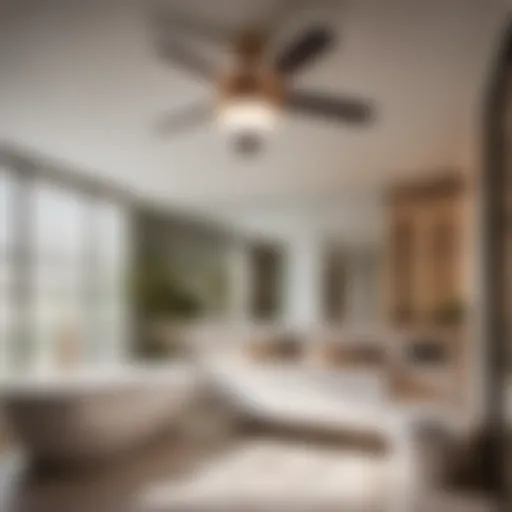Unveiling Water Issues Beneath a Bathroom Floor: Causes, Signs, and Solutions
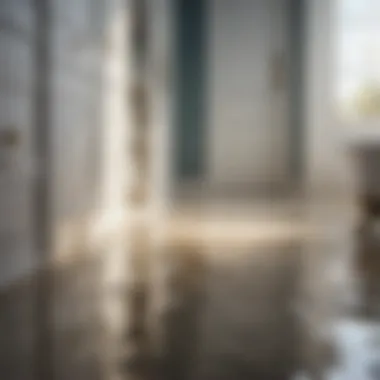

Materials:
- Waterproofing membrane: 1 roll (measuring 4ft x 50ft) to ensure a secure barrier against water infiltration.
- PVC waterproofing adhesive: 1 gallon for adequate application of the membrane.
- Polymer-modified mortar: 2 bags to create a strong, durable base for the flooring.
- Porcelain tiles: Sufficient quantity based on the area to cover for a water-resistant and aesthetically pleasing finish.
DIY Steps:
- Preparation: Clear the bathroom area, ensuring it is free from any existing flooring and debris. Measure the dimensions accurately to determine material quantities needed.
- Applying Waterproofing Membrane: Unroll the membrane and cut to fit the bathroom floor, ensuring complete coverage. Use PVC waterproofing adhesive to secure the membrane in place.
- Preparing Mortar: Mix the polymer-modified mortar according to the manufacturer's instructions until a smooth consistency is achieved.
- Applying Mortar and Setting Tiles: Spread the mortar evenly on the floor surface using a trowel, then lay the porcelain tiles carefully in the desired pattern. Allow sufficient time for the mortar to set.
- Grouting: Fill the gaps between tiles with grout using a grout float, ensuring a tight seal to prevent water penetration.
Technical Aspects:
- Tools Required: Trowel, grout float, utility knife, measuring tape.
- Timing Specifics: Allow 24 hours for the waterproofing membrane to dry before proceeding with mortar application.
- Critical Techniques: Ensure proper alignment of tiles and thorough grouting to maintain water resistance.
DIY Project Process:
- Start by meticulously clearing the bathroom area and measuring accurately to avoid material wastage.
- Precisely apply the waterproofing membrane and mortar using recommended techniques to guarantee a secure installation.
Troubleshooting Tips:
- In case of uneven tiles, gently adjust their position before the mortar sets completely.
- If excess mortar or grout seeps out, clean it immediately to avoid unsightly residue.
Introduction
In the realm of household upkeep, few issues can be as insidious and damaging as water accumulation underneath a bathroom floor. this article delves into the critical matters surrounding this prevalent problem, shedding light on the potential dangers it poses. Understanding the causes, signs, and remediation methods associated with water under the bathroom floor is paramount for maintaining a safe and habitable living space. By grasping the intricacies of this issue, homeowners can proactively safeguard their property against significant structural harm and health risks.
Overview of the Problem
Impact of Water Under Bathroom Floor
Water seepage beneath the bathroom floor can lead to a cascade of detrimental effects on the overall integrity of the dwelling. From compromising the foundation to fostering the growth of hazardous molds, the presence of water beneath the bathroom floor is a silent yet formidable threat. Detecting and addressing this issue promptly is crucial to prevent escalation and costly repairs.
Potential Causes
The causes of water accumulation beneath bathroom floors are manifold, ranging from leaking fixtures like faulty pipes to inadequate waterproofing measures. Each potential cause brings its unique set of challenges and consequences, underscoring the necessity of a thorough investigation to determine the root source. By comprehensively understanding these factors, homeowners can strategize effective solutions tailored to their specific circumstances.
Importance of Timely Detection
Structural Damage
The insidious nature of water beneath the bathroom floor lies in its ability to wreak havoc on the structural integrity of the entire home. Left unchecked, water infiltration can weaken foundations, erode support structures, and lead to irreparable damage. Timely detection and intervention are paramount to prevent extensive harm and preserve the longevity of the property.
Health Concerns
Beyond structural implications, the presence of water under the bathroom floor poses significant health hazards to occupants. Moisture-laden environments provide a breeding ground for mold and mildew, allergens, and pathogens, jeopardizing the well-being of those residing within the premises. Addressing water issues promptly is vital to mitigate health risks and uphold a safe living environment.
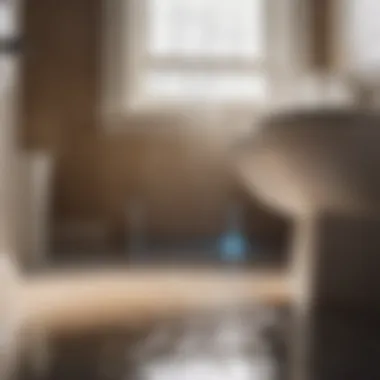

Identifying the Issue
Identifying the issue of water under the bathroom floor is a fundamental step in addressing potential problems efficiently. By recognizing early signs and manifestations of water accumulation beneath the floor surface, homeowners can proactively take measures to mitigate further damage. Timely identification is crucial in preventing structural damage and ensuring a healthy living environment. Through a thorough assessment of the signs of water under the bathroom floor, individuals can safeguard their property and well-being.
Signs of Water Under Bathroom Floor
Dampness
Dampness is a key indicator of water presence beneath the bathroom floor. It manifests as wet or moist areas on the floor surface, indicating possible leakage or seepage. Dampness not only compromises the structural integrity of the floor but also creates a conducive environment for mold growth. Addressing dampness promptly is essential to prevent extensive damage to the subfloor and surrounding structures. While identifying dampness may seem straightforward, its implications can be severe if left unattended.
Mold Growth
Mold growth is a serious consequence of prolonged water exposure under the bathroom floor. It not only poses health risks to occupants but also signifies underlying moisture issues. The appearance of mold patches, discoloration, or a musty smell indicates the presence of excess moisture, necessitating immediate attention. Professional intervention may be required to assess the extent of mold infestation and implement effective remediation strategies. Ignoring mold growth can lead to respiratory problems and structural deterioration, underscoring the importance of timely detection and action.
Musty Odor
A musty odor is a telltale sign of water accumulation underneath the bathroom floor. The distinctive smell arises from trapped moisture, allowing mold and bacteria to thrive in hidden spaces. Musty odors signal a potential mold infestation, emphasizing the need for thorough inspection and remediation. While masking agents may temporarily cover the odor, addressing the root cause is essential for long-term prevention. Homeowners should not overlook musty odors, as they are indicative of underlying water issues that can escalate if untreated.
Professional Inspection
Importance of Expert Assessment
Professional inspection by experienced technicians is invaluable in evaluating water issues under the bathroom floor. Experts possess the knowledge and tools to identify hidden water sources, assess damage, and recommend suitable solutions. Their expertise enables accurate diagnosis and targeted interventions, reducing the risk of future complications. Engaging professionals for inspection provides homeowners with detailed insights and actionable recommendations, ensuring comprehensive remediation of water-related problems.
Utilizing Moisture Meters
The use of moisture meters is a precise method employed during inspections to determine moisture levels in the bathroom floor. These devices detect hidden water pockets, facilitating a thorough assessment of the extent of water damage. Moisture meters enable technicians to pinpoint problem areas, track potential leaks, and devise effective repair strategies. By utilizing moisture meters, professionals enhance the accuracy of their evaluations, enabling efficient resolution of water under the bathroom floor issues.
Causes of Water Accumulation
Water accumulation underneath a bathroom floor can result from various factors that, if left unaddressed, can lead to significant issues within the structure. Understanding the causes of water accumulation is vital in effectively tackling the root problem and preventing further damage. Leaking fixtures, poor waterproofing, and external factors are common culprits that contribute to this issue. By delving into each of these causes, one can gain a comprehensive overview of the potential sources of water seepage and employ appropriate remediation strategies to safeguard the integrity of the building.
Leaking Fixtures
Leaking fixtures such as faulty pipes and worn-out seals play a crucial role in the buildup of water under a bathroom floor. Faulty pipes, characterized by corrosion, cracks, or loosened connections, can result in significant leakage over time. Identifying and addressing faulty pipes promptly is essential to prevent extensive water damage and mold growth. On the other hand, worn-out seals around fixtures like sinks and toilets can allow water to seep into the flooring, promoting dampness and microbial growth. Regular inspection and maintenance of these fixtures are imperative in mitigating the risk of water accumulation and preserving the structural integrity of the building.
Faulty Pipes
Faulty pipes are a key component contributing to water accumulation issues underneath a bathroom floor. These pipes, whether due to aging, damage, or poor installation, can develop leaks that result in water seepage. The presence of faulty pipes can lead to substantial water damage, compromising the stability of the flooring and potentially causing health hazards due to mold growth. It is essential to address faulty pipes promptly to prevent further complications and ensure a safe living environment.
Worn-out Seals
Worn-out seals serve as another significant factor in water accumulation concerns. Over time, seals around fixtures can degrade, lose their elasticity, or sustain damage, allowing water to infiltrate the floor surface. The deterioration of seals can lead to moisture penetration, triggering issues like dampness and unpleasant odors. Addressing worn-out seals through timely replacement or repair is essential in maintaining a watertight barrier and preventing moisture-related problems within the bathroom area.
Poor Waterproofing
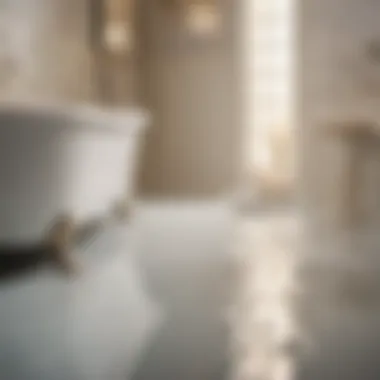

Inadequate sealant and substandard materials used in waterproofing can also contribute to water accumulation beneath a bathroom floor. High-quality sealant is essential in creating a waterproof barrier that prevents water from seeping through surfaces. Additionally, using substandard materials in the waterproofing process can compromise its effectiveness, leaving vulnerabilities that enable water infiltration. Ensuring proper application of sealant and selecting quality materials are paramount in enhancing the resilience of the waterproofing system and minimizing the risk of water damage.
Inadequate Sealant
The use of inadequate sealant in waterproofing applications can result in water seepage issues in bathroom floors. Ineffective sealant products may lack durability or adhesion properties, leading to premature deterioration and water penetration. It is crucial to choose high-quality sealants designed for wet environments and ensure thorough application to achieve a reliable moisture barrier. Addressing inadequacies in sealant can significantly mitigate water accumulation problems and preserve the structural integrity of the flooring.
Substandard Materials
Utilizing substandard materials during the waterproofing process can compromise the effectiveness of the protective barrier against water intrusion. Inferior materials may have inferior resistance to moisture or may degrade quickly when exposed to water, diminishing their ability to prevent leaks or seepage. Selecting premium materials known for their durability and waterproofing capabilities is vital in establishing a long-lasting defense against water damage and ensuring the sustainability of the bathroom flooring.
External Factors
External factors like groundwater seepage and flooding can also impact the accumulation of water underneath a bathroom floor. Groundwater seepage occurs when water from the surrounding soil infiltrates the foundation or basement, affecting the floor structure. Similarly, flooding, whether from heavy rainfall or plumbing mishaps, can introduce large volumes of water into the interior space, increasing the risk of water damage. Implementing measures to address external factors, such as proper drainage systems and waterproofing of external walls, is essential in mitigating the impact of groundwater and flood-related water accumulation, safeguarding the stability of the building.
Groundwater Seepage
Groundwater seepage poses a significant threat to the structural integrity of a building's foundation and can contribute to water accumulation beneath bathroom floors. The continuous pressure from groundwater can compromise the waterproofing systems in place, leading to infiltration and dampness issues within the flooring. Implementing effective drainage solutions and waterproofing measures around the foundation can help mitigate the effects of groundwater seepage and prevent water-related damage in the bathroom area.
Flooding
Flooding events, whether due to natural disasters or plumbing failures, can inundate the interior space with water, risking extensive damage to the flooring and surrounding structures. Addressing the aftermath of a flood requires swift action to remove excess water, dry out affected areas, and assess the extent of damage. Implementing preventive measures such as installing flood barriers and maintaining functional plumbing systems can reduce the likelihood of flooding incidents and minimize the impact of water accumulation underneath the bathroom floor.
Addressing the Problem
Repairing Leaks
Replacing Faulty Pipes
Replacing faulty pipes stands as a cornerstone in the realm of remedying water leaks beneath bathroom floors. The essence of this method lies in addressing the root cause of water seepage, thereby preventing further damage. The key characteristic of replacing faulty pipes is its ability to provide a long-term solution to recurrent leaks, ensuring a durable and watertight plumbing system. While the process may entail initial investment, the benefits of enhanced durability and minimized maintenance make it a preferred choice for resolving water leakage issues.
Repairing Seals
Repairing seals plays a crucial role in addressing water leakage beneath bathroom floors with precision. The fundamental feature of this approach is its efficacy in sealing off potential entry points for water, safeguarding the underlying structures. By focusing on repairing seals, homeowners can fortify vulnerable areas prone to moisture intrusion, mitigating the risk of extensive water damage. The unique aspect of repairing seals lies in its targeted reinforcement of leak-prone areas, offering a tailored solution to specific water-related concerns within the bathroom environment.
Improving Waterproofing
Reapplying Sealant
When it comes to enhancing waterproofing measures, reapplying sealant emerges as a fundamental practice in fortifying bathroom floors against water infiltration. The crux of reapplying sealant lies in its ability to maintain a consistent barrier against moisture, preventing water seepage and potential damage. With a focus on reapplying sealant, homeowners can ensure that their bathroom floors remain adequately protected, fostering a resilient and water-resistant environment. The distinctive feature of reapplying sealant is its versatility in accommodating different floor types, providing a customizable solution tailored to the specific waterproofing needs of the bathroom space.
Upgrading Materials
Upgrading materials stands as a proactive approach to bolstering the waterproofing integrity of bathroom floors, minimizing the risk of water-related issues. The key characteristic of upgrading materials is its capacity to offer enhanced durability and longevity, elevating the overall resilience of the flooring system. By prioritizing the use of high-quality materials, homeowners can instill a higher level of protection against water infiltration, ensuring long-term structural integrity and peace of mind. The unique feature of upgrading materials lies in its versatility, allowing for tailored solutions that cater to the individual waterproofing requirements of the bathroom area.
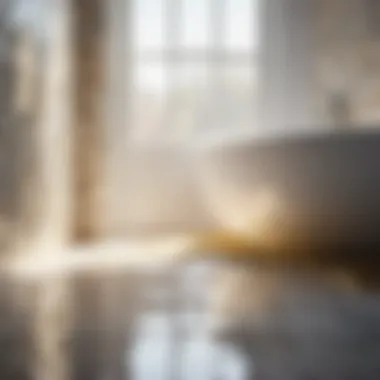

Mitigating External Factors
Installing Drainage Systems
Mitigating external factors through the installation of drainage systems plays a pivotal role in safeguarding bathroom floors against water ingress from surrounding sources. The key characteristic of installing drainage systems is its efficacy in channeling excess water away from the building, reducing the likelihood of water accumulation beneath the bathroom floor. By strategically implementing drainage systems, homeowners can proactively address external water threats, enhancing the overall resilience of their living space. The unique feature of drainage systems lies in their adaptability to diverse landscapes, offering a customizable solution to manage varying degrees of groundwater seepage and flooding risks.
Waterproofing External Walls
Waterproofing external walls serves as a crucial measure in fortifying the perimeter of a structure against water penetration, complementing the efforts to address water issues beneath the bathroom floor. The essence of waterproofing external walls lies in creating a seamless barrier that prevents moisture from seeping into the building envelope, safeguarding the interior spaces. By focusing on waterproofing external walls, homeowners can bolster the overall waterproofing system of their property, ensuring comprehensive protection against external water threats. The unique feature of waterproofing external walls is its ability to enhance the aesthetic appeal of the building facade while providing a durable shield against inclement weather conditions and groundwater seepage.
Preventive Measures
Regular Maintenance
Checking for Leaks
When it comes to regular maintenance, checking for leaks is a crucial aspect in ensuring the early detection of any water seepage beneath the bathroom floor. By inspecting plumbing fixtures, pipes, and seals for signs of leakage, homeowners can identify and address issues promptly, preventing further damage. The key characteristic of checking for leaks lies in its ability to proactively identify potential water problems before they escalate. This proactive approach not only saves on repair costs but also promotes a proactive mindset towards maintaining a healthy living environment. Despite its benefits, one disadvantage of checking for leaks is the time and effort it demands, but the long-term advantages far outweigh this initial investment.
Inspecting Sealant
Inspecting sealant is another essential component of regular maintenance when it comes to preventing water issues underneath a bathroom floor. Ensuring that the sealant around fixtures, joints, and seams remains intact is crucial in preventing water penetration. The key characteristic of inspecting sealant is its role in fortifying the waterproofing of the bathroom floor, which is vital for protecting against moisture damage. By examining the condition of the sealant regularly, homeowners can address any deteriorating areas promptly, thus prolonging the lifespan of the flooring. While the advantage of inspecting sealant lies in its cost-effective nature and ease of implementation, one disadvantage may be the need for frequent checks depending on the sealant quality.
Proactive Waterproofing
Scheduled Reapplication
Scheduled reapplication of waterproofing products is a proactive measure that can significantly enhance the longevity and durability of a bathroom floor. By adhering to a regular schedule for reapplying waterproof sealants and coatings, homeowners can maintain a strong barrier against water infiltration. The key characteristic of scheduled reapplication is its preventive nature, which helps in addressing wear and tear on existing waterproofing layers. This timely maintenance can prevent water accumulation under the floor surface, thereby minimizing the risk of structural damage. While the advantage of scheduled reapplication lies in its effectiveness in prolonging the integrity of the waterproofing system, one potential disadvantage may be the recurring cost associated with purchasing sealing products.
Using High-Quality Products
Opting for high-quality waterproofing products is imperative when considering proactive measures to prevent water issues beneath a bathroom floor. The key characteristic of using high-quality products lies in their superior durability and resistance to water damage, offering long-term protection for the flooring. By investing in reputable waterproofing materials, homeowners can ensure a reliable defense against leaks and moisture infiltration. The unique feature of using high-quality products is their ability to withstand varying environmental conditions, providing a robust shield against potential water damage. While the advantage of using high-quality products is evident in their long-lasting performance and reliability, a potential disadvantage could be the upfront cost compared to lower-quality alternatives.
Conclusion
Water issues underneath a bathroom floor can pose significant risks to both the structural integrity of a home and the health of its occupants. Recognizing and addressing water problems promptly is paramount to ensuring a safe and resilient living environment. By following the steps outlined in this comprehensive guide, homeowners can proactively manage potential water-related challenges and maintain the longevity of their property.
Summary of Key Points
Early Detection is Crucial
Early detection acts as the first line of defense against water damage under the bathroom floor. It enables homeowners to identify underlying issues at their nascent stage, preventing extensive and costly repairs down the line. The ability to spot signs of water accumulation early significantly reduces the risk of structural compromises and mold infestations. Emphasizing vigilance in monitoring dampness, mold growth, and musty odors can safeguard against severe repercussions, underscoring the importance of proactive oversight.
Timely Repairs Prevent Extensive Damage
Timely repairs play a pivotal role in mitigating the impact of water issues underneath a bathroom floor. Addressing leaks promptly and reinforcing waterproofing measures are crucial steps in preventing further deterioration and minimizing repair costs. By swiftly resolving identified concerns and enhancing protective barriers, homeowners can avert the escalation of damage and uphold the condition of their property. Implementing immediate action upon detection showcases a responsible and proactive approach, safeguarding the longevity and value of the home.
Importance of Regular Checks
Ensuring Long-Term Structural Integrity
Regular checks are instrumental in upholding the long-term structural integrity of a residence. Consistent monitoring can reveal subtle indications of water infiltration, allowing for timely interventions to preserve the stability of the building. Proactive assessments enable homeowners to detect vulnerabilities early, facilitating the implementation of necessary reinforcements and repairs. By incorporating regular checks into their maintenance routines, individuals can fortify the structural foundation of their home and ensure its resilience against potential water-related threats.

